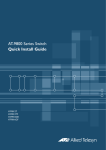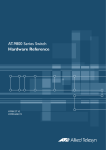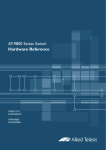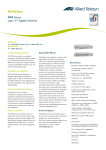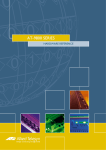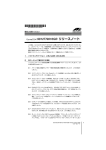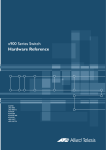Download Allied Telesis AT-9816GB Install guide
Transcript
AT-9800 Series Switch Quick Install Guide AT-9812T V2 AT-9816GB V2 AT-9800 Series Switch Quick Install Guide Document Number C613-04038-01 REV H. © 2003-2007 Allied Telesis, Inc. All rights reserved. No part of this publication may be reproduced without prior written permission from Allied Telesis, Inc. Allied Telesis, Inc. reserves the right to make changes in specifications and other information in this document without prior written notice. The information provided herein is subject to change without notice. In no event shall Allied Telesis, Inc. be liable for any incidental, special, indirect, or consequential damages whatsoever, including but not limited to lost profits, arising out of or related to this manual or the information contained herein, even if Allied Telesis, Inc. has been advised of, known, or should have known, the possibility of such damages. All company names, logos, and product designs that are trademarks or registered trademarks are the property of their respective owners. Quick Install Guide 3 Models Covered By This Guide This Quick Install Guide includes information on the following models: ■ AT-9812T V2 ■ AT-9816GB V2 Package Contents The following items are included with each AT-9800 Series switch. Contact your sales representative if any items are damaged or missing. ■ One AT-9800 Series switch ■ One AC power cord (for AC models) ■ One serial cable for connecting the switch to a terminal or PC ■ One 19 inch rack-mount kit ■ One AT-9800 Series Switch Quick Install Guide ■ One AT-9800 Series Safety and Statutory Information booklet ■ One AT-9800 Series Switch Documentation and Tools CD-ROM (which includes the complete AT-9800 Series document set and utilities) ■ One warranty card Selecting a Site The switch can be installed in a standard 19-inch rack or on a level surface such as a desktop or bench. When installing the switch, choose a site that: C613-04038-01 REV H ■ allows adequate airflow around the switch and its vents. ■ is free of dust and moisture. ■ will maintain an ambient temperature range of 0–40º C (32–104º F) and a humidity range of 5–95% non-condensing. ■ has a reliable and earthed (grounded) power supply circuit, preferably dedicated and filtered. ■ does not expose cabling to sources of electrical noise, such as radio transmitters, broadband amplifiers, power lines, electric motors, and fluorescent fixtures. ■ allows easy access to the switch’s power and cable connections. ■ will allow all related network devices to be connected to the switch without exceeding maximum cable length limitations. See the AT-9800 Series Switch Hardware Reference for cable length specifications. 4 AT-9800 Series Switch Installing the Switch This equipment must be earthed. Follow these steps to install the switch: 1. Read the safety information For safety information, see the AT-9800 Series Safety and Statutory Information booklet. A copy of this booklet is supplied with each switch, and can also be found on the Documentation and Tools CD-ROM or at www.alliedtelesis.com/support/software. 2. Gather the tools and equipment you will need If installing a DC version of the switch, you will need a DC power source, DC supply cable, and ring connectors (see Step 8). If the switch is to be connected to a redundant power supply, you will need a redundant power supply unit and cable (see Step 10). 3. Choose a suitable site for the switch Either a flat surface or 19-inch rack. 4. Unpack the switch Verify the package contents. If any items are damaged or missing, contact your sales representative. 5. Install CAM (Optional) If you purchased a Content Addressable Memory (CAM) module, install it now by following the instructions in the CAM Quick Install Guide. The CAM Quick Install Guide can be found on the AT-9800 Series Switch Documentation and Tools CD-ROM, or can be downloaded from www.alliedtelesis.com/support/software. 6. Place the switch in its operating location If installing the switch in a rack: 7. • Remove the rubber feet • Attach the rack-mounting brackets • Mount the switch in the rack Apply AC power to the switch (for AC models) Plug the power cord into the AC power connector on the rear panel of the switch (Figure 1 on page 5). The Fault LED should flash for approximately 10 seconds as the switch runs internal tests. If the LED continues to flash or remains lit, refer to the AT-9800 Series Switch Hardware Reference for troubleshooting information. C613-04038-01 REV H Quick Install Guide 5 Figure 1: AT-9816GB front panel and rear panel with AC power inlet AT-9816GB V2 Layer 3 Fast Ethernet Switch 1000BASE-X GBIC PORT ACTIVITY L/A GBIC L/A 1 2 3 4 5 6 7 LINK / FULL DUP ACTIVITY LINK / HALF DUP ACTIVITY ENABLED DISABLED FAULT 8 1 2 3 4 5 6 7 RS-232 TERMINAL PORT STATUS ASYN0 FAULT 8 L/A GBIC RPS L/A PWR GBIC 9 10 11 12 13 14 15 16 9 10 11 12 13 14 15 RESET 16 COMPACT FLASH AC INPUT HZ AMPS 100-240V 50/60 5.0/2.5 RPS INPUT VDC A Max +3.3 16 +5 16 +12 0.5 AC Power ACTIVITY CLASS 1 LASER AT-RPS9000 RPS Connector 8. Compact FLASH Apply DC power to the switch (for DC models) Read the AT-9800 Series Safety and Statutory Information booklet before connecting a DC power supply. A copy of this booklet is included with each switch. It is also included on the Documentation and Tools CD-ROM, or can be downloaded from www.alliedtelesis.com/support/software. Only trained and qualified personnel should connect a DC power supply. Due to exposed terminals, DC powered switches should only be installed in Restricted Access Areas. DC supply cable specifications (one cable is required for each PSU): • Number of wires (cores): 3 • Minimum size: 2.1mm2 (14 AWG) • Minimum cable rating: 600 V, 90 degrees Celsius DC power supply specifications: • 48V DC (40–60 VDC is acceptable) • Either positive grounded or negative grounded Circuit protection: • Use a 10 Amp circuit breaker Ensure the supply cable is not live. C613-04038-01 REV H a) Strip the supply cable wires to expose 8mm (0.31in) of bare conductor b) At the switch, connect the ground wire to the ground terminal. The terminals can be identified by the diagram on the rear panel of the switch. Tighten the terminal to between 0.6 and 0.8Nm (0.041 to 0.055 pound force per foot). c) At the switch, connect the positive feed to the + (positive) terminal and the negative feed to the - (negative) terminal. Tighten the terminal to between 0.6 and 0.8Nm (0.041 to 0.055 pound force per foot). 6 AT-9800 Series Switch d) Ensure that there are no exposed conductor strands. e) Secure the supply cable to the rack framework or similar object so that the connections are isolated from any forces applied to the cable. f) Ensure that the circuit breaker is in the OFF position. g) Connect the supply cable wires to the circuit breaker. h) Energise the circuit breaker. The Fault LED should flash for approximately 10 seconds as the switch runs internal tests. If the LED continues to flash or remains lit, refer to the AT-9800 Series Switch Hardware Reference for troubleshooting information. 9. Check that the Power LED on the switch’s front panel lights green If the LED fails to light, refer to the AT-9800 Series Switch Hardware Reference for troubleshooting information. 10. Connect the Redundant Power Supply (Optional) AC models of AT-9800 Series switches have a Redundant Power Supply (RPS) connector on their rear panel, and can be used with an AT-RPS9000 Redundant Power Supply. The AT-RPS9000 must be purchased separately. Contact your authorised Allied Telesis distributor or reseller for more information. 11. Install GBICs Any combination of copper and fibre GBICs can be installed in AT-9812T and AT-9816GB switches. Slide the GBICs into the GBIC slots. Press each GBIC firmly into place. A range of GBICs have been tested and approved for use with AT-9800 Series switches. For more information, contact your authorised Allied Telesis distributor or reseller, or visit www.alliedtelesis.com. RX and TX terminal locations on SC fibre GBIC ports are the reverse of RX and TX terminal locations on fixed SC fibre ports. When looking at an SC fibre GBIC from the front, the RX terminal is on the left and the TX terminal is on the right. 12. Connect the data cables Make sure each cable connection is secure. The switch will now perform basic Layer 2 switching functions. C613-04038-01 REV H Quick Install Guide 7 Configuring the Switch Some configuration is necessary to enable the advanced switching capabilities of the switch. The switch can be configured via the Command Line Interface (CLI) or Graphical User Interface (GUI). Using the CLI to configure a switch 1. Connect a terminal or PC to RS-232 (ASYN0) Using the supplied RS-232 DB9 straight-through cable, connect your terminal or PC to the RS-232 Terminal Port on the switch’s front panel. 2. Set the communication parameters Set the communication parameters on your terminal or terminal emulation program to: 3. • Baud rate: 9600 • Data bits: 8 • Parity: None • Stop bits: 1 • Flow control: Hardware Check the power supply Ensure that the On/Off switch (AC models) or Run/Standby switch (DC models) is in the On or Run position and that the switch is receiving power (Power LED lights green). 4. Log in After the switch has booted, the log in prompt appears. If the log in prompt doesn’t appear, press [Enter] two or three times. When the switch boots for the first time it automatically creates an account with manager privileges. The account has the log in name “manager” and the password is “friend”. At the log in prompt, enter the log in name and password. Login: manager Password: friend The command prompt appears and you can now configure the switch using the command line interface. Change the password as soon as possible. Leaving the manager account with the default password is a serious security risk. Make sure you remember the new password as there is no way to retrieve it if it is lost. Use the following command to change the account password: set password To display a list of help topics, enter: help To display help on a specific topic, enter: help topic C613-04038-01 REV H 8 AT-9800 Series Switch Alternatively, type a question mark (?) at the end of a partially completed command to see a list of valid options. See the AT-9800 Series Switch AlliedWare™ Operating System Software Reference for more information on configuring the switch. Using the GUI to configure a switch This section describes how to establish a connection to the switch through the GUI, so you can configure the switch before installing it in your LAN. 1. Select a PC to browse to the switch from You can browse to the switch from any PC that is running a supported operating system with a supported browser installed, with JavaScript enabled. If you are using a toolbar or plug-in on your browser to block pop-ups, disable it while using the GUI. The GUI displays detailed configuration options and information in pop-up windows. You need to know the PC’s subnet. 2. Connect the PC to the switch Use an Ethernet cable to connect an Ethernet card on the PC to any one of the switch ports. You can browse to the router through any VLAN, as long as you give that VLAN an IP address. These instructions assume you will use vlan1. The switch ports all belong to vlan1 by default. 3. Access the switch’s command line interface Access the CLI from the PC, as described in the previous “Using the CLI to configure a switch” section. 4. Enable IP enable ip 5. Assign the vlan1 interface an IP address in the same subnet as the PC add ip interface=vlan1 ip=ipaddress mask=mask 6. Save the configuration and set the switch to use it on bootup create config=your-name.cfg set config=your-name.cfg 7. On the PC’s web browser, bypass the HTTP proxy server, if necessary 8. Point your web browser at vlan1’s IP address 9. At the login prompt, enter the user name and password The default username is manager: User Name: manager Password: friend The System Status page is displayed. Select options from the sidebar menu to configure and manage the switch. For context-sensitive online help, click on the Help button at the top of the sidebar menu or on any pop-up page. C613-04038-01 REV H Quick Install Guide 9 System LEDs The following LEDs report operations and faults on AT-9800 Series switches (Table 1). Table 1: System LEDs on AT-9800 Series switches LED State Function PWR Green The switch is receiving power Red The switch or management software is malfunctioning 1 Flash A switch fan has failed or is operating below the recommended speed 2 Flashes If RPS monitoring is enabled, an RPS fan has failed or is operating below the recommended speed 3 Flashes If an RPS is connected, the switch’s PSU (Power Supply Unit) has failed 4 Flashes If RPS monitoring is enabled, the RPS PSU has failed 5 Flashes If RPS monitoring is enabled, an RPS is not connected or is not operational 6 Flashes The switch’s temperature has exceeded the recommended threshold RPS (Redundant Power Supply) Green An RPS is connected to the switch and is receiving power CompactFlash Activity (Rear panel) Green The compact flash memory is active. Do not eject the flash memory module (Power) Fault The AT-9800 Series Switch Hardware Reference has further troubleshooting information, including information on switch port LEDs. C613-04038-01 REV H 10 AT-9800 Series Switch Documentation and Tools CD-ROM The Documentation and Tools CD-ROM bundled with each switch contains the complete Documentation Set for AT-9800 Series switches and their expansion options, as well as tools for managing the Switch. The CD-ROM includes: ■ The AT-9800 Series Statutory and Safety Information booklet, which provides safety and statutory information for the Switch and its expansion options. ■ The AT-RPS9000 Statutory and Safety Information booklet, which includes important safety information and statutory declarations for the AT-RPS9000 chassis and AT-PWR9000 power unit. ■ The AT-9800 Series Switch Hardware Reference, which provides detailed information on the hardware features of AT-9800 Series switches. ■ This Quick Install Guide. ■ The AT-RPS9000 & AT-PWR9000 Quick Install Guide, which outlines the procedure for installing AT-RPS9000 chassis and AT-PWR9000 power units. ■ The AT-9800 Series Switch AlliedWare™ Operating System Software Reference, which provides detailed information on configuring the switch and its software. ■ The CAM Quick Install Guide, which outlines the procedure for installing Content Addressable Memory. ■ AT-TFTP Server for Windows, for downloading software releases. ■ Adobe Acrobat Reader, for viewing online documentation. C613-04038-01 REV H










